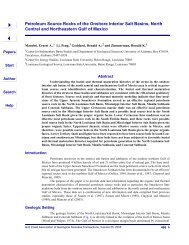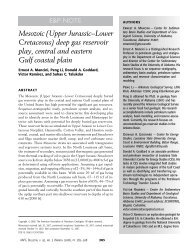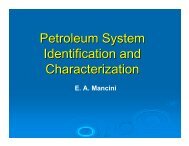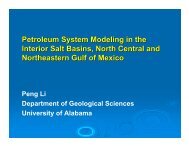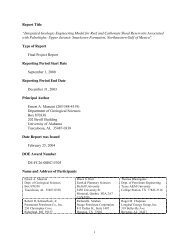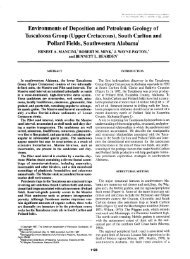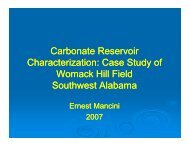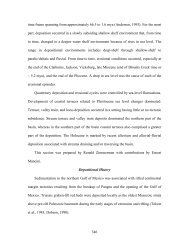Hydrocarbon Generating Potential - Berg - Hughes Center
Hydrocarbon Generating Potential - Berg - Hughes Center
Hydrocarbon Generating Potential - Berg - Hughes Center
- No tags were found...
You also want an ePaper? Increase the reach of your titles
YUMPU automatically turns print PDFs into web optimized ePapers that Google loves.
<strong>Hydrocarbon</strong> <strong>Generating</strong> <strong>Potential</strong>:Jurassic Cotton Valley – Bossier Group, North Louisiana Salt BasinDonald A. Goddard 1 , Ernest A. Mancini 2 , Marty Horn 3 , and Suhas C. Talukdar 41 <strong>Center</strong> For Energy Studies, Louisiana State University, 1081 Energy, Coast andEnvironment Bldg., Nicholson Extension, Baton Rouge, Louisiana 708032 Department of Geological Sciences, University of Alabama,202 Bevill St., Tuscaloosa, Alabama 354873 Louisiana Geological Survey, Louisiana State University, 2101 Energy, Coast andEnvironment Bldg., Nicholson Extension, Baton Rouge, Louisiana 708034 Baseline Resolution, Inc., 143 Vision Park Blvd., Shenandoah, Texas 77384ABSTRACTGeological/geochemical evaluation of Upper Jurassic Cotton Valley – Bossier coresamples from the North Louisiana Salt Basin (NLSB) indicates that fine-grained rocksassociated with these units are thermally mature and represent petroleum source rockthat generated and expelled mostly gas and some oil. These findings are based on sourcerock characterization of samples from wells within the NLSB, Vernon Field, JacksonParish, using total organic carbon (TOC), Rock-Eval pyrolysis, and visual kerogen data.The data indicate that these rocks at their present maturity level have low to moderateTOC contents and Type III kerogen. Original kerogen types in the immature stage,as assessed by kerogen petrography, were mainly gas-prone Type III and some oil-andgas-prone Type II/III. The principal macerals are partly oxidized, unstructured amorphousorganic matter (liptinite) and vitrinite in varying proportions. Amorphous materialwas derived from degraded marine algal and humic matter (higher plant material).Visual kerogen data support the predominantly gas-prone nature of the source rocks.Vitrinite reflectance (R o ) values (0.94% to 2.62%) and thermal alteration indices (TAI)(2.8 to 3.7) suggest that these source rocks entered the late oil window to main gas maturitywindow and thus have generated mostly gas with some oil. Thin section petrographyof geochemically analyzed intervals documents the following rock types: muddyfine-grained sandstone, laminated fine-grained sandstone, sandy mudstone, and siltymudstone. These combined analytical results indicate that abundant woody organicmaterial of continental origin was deposited in offshore areas in association with finesiliciclastic sediments in a marine prodelta environment during Jurassic time. Thethickness and widespread deposition of predominantly gas-prone rocks within the NLSBand their high thermal maturity led to sourcing of mainly gas with some oil in overlyingJurassic and Cretaceous reservoirs, particularly in the Bossier and Cotton Valley.Goddard, D. A., E. A. Mancini, M. Horn, and S. C. Talukdar, 2008, <strong>Hydrocarbon</strong> generating potential: Jurassic CottonValley – Bossier Group, North Louisiana Salt Basin: Gulf Coast Association of Geological Societies Transactions, v. 58,p. 305-325.305Copyright © 2008, The Gulf Coast Association of Geological Societies. All Rights Reserved.
Goddard et al.Figure 1. Regional map showing the north-south and west-east cross sections with cored (red) and selectedwells (white) that penetrate the Cotton Valley – Bossier Group within the NLSB.Four Bossier shale samples were analyzed from two wells in the Vernon Field, Jackson Parish (Fisher 16-1and Davis Bros 29-2). The results obtained are similar to other Bossier samples analyzed in the NLSB and liewithin the type III range on the TOC versus S 2 plot (Figs. 6A and 6B). On the HI versus OI diagram, they plotwithin the gas-prone area as well (Fig. 7).In two other Vernon Field wells, shale layers within the Cotton Valley interval were also sampled (StewartHarrison and Beasley 9-2). The TOC, S 1 , S 2 , and T max values in the samples are considerably higher than those ofthe Bossier shales (Table 5). Such values indicate that their generative potential is very good (Peters, 1986; Jarvie,1991). They plot with the Bossier and Haynesville samples on the HI versus OI diagram (Fig. 7) and withhigh TOC of 4.5 on the TOC versus S 2 diagram (Fig. 6A).KEROGEN PETROGRAPHYVitrinite reflectance (R o ) has been used successfully by petroleum geochemists for several years as an indicatorof organic maturation in sedimentary rocks (Senftle and Landis, 1991). In this study, this technique, incombination with Rock-Eval pyrolysis, allowed us to assess the quality and maturity of the kerogen present in theCotton Valley – Bossier Group strata. When the results of the kerogen analyses are plotted on the %R o versus308Copyright © 2008, The Gulf Coast Association of Geological Societies. All Rights Reserved.
Figure 2. Electric logs from cored wells in the NLSB with major stratigraphic boundaries (Cotton Valley, Bossier, and Haynesville) and depthsfor samples analyzed and thin section micrographs (red circles).<strong>Hydrocarbon</strong> <strong>Generating</strong> <strong>Potential</strong>: Jurassic Cotton Valley – Bossier Group, North Louisiana Salt Basin309Copyright © 2008, The Gulf Coast Association of Geological Societies. All Rights Reserved.
Goddard et al.Table 2. Cotton Valley – Bossier Group samples in Vernon Field selected for analyses.Ser# / API# Operator Well Field Sec TWP RGE ParishSampleDepth (ft)224274 Anadarko Fisher 16-1 Vernon 16 16N 02W Jackson 13,175170492033213,7702267421704920390AnadarkoDavis Bros.29-2Vernon 29 16N 02W Jackson 14,03515,1202318131704920649Anadarko Beasley 9-2 Vernon 9 16N 02W Jackson 11,3482323161704920665Anadarko Stew.-Harr. 34-2 Vernon 34 16N 03W Jackson 11,805Figure 3. Map of Vernon Field, Jackson Parish, with sampled wells 1, 2, 3, and 4 highlighted in red.310Copyright © 2008, The Gulf Coast Association of Geological Societies. All Rights Reserved.
<strong>Hydrocarbon</strong> <strong>Generating</strong> <strong>Potential</strong>: Jurassic Cotton Valley – Bossier Group, North Louisiana Salt BasinFigure 4. Electric logs for wells selected from Vernon Field, Jackson Parish, showing depths wheresamples chosen for analysis and thin section micrographs (red circles). The Anadarko Davis Bros. 29#2Alt sample at 15,120 ft (4609 m) depth is not shown at the scale of the electric logs.311Copyright © 2008, The Gulf Coast Association of Geological Societies. All Rights Reserved.
<strong>Hydrocarbon</strong> <strong>Generating</strong> <strong>Potential</strong>: Jurassic Cotton Valley – Bossier Group, North Louisiana Salt Basindepth plot (Fig. 8) and correlated with other common organic maturation parameters (Senftle and Landis, 1991),the data fall primarily in the principal zone of gas formation. The principal macerals observed with the visualkerogen analysis (liptinite, vitrinite, and minor amounts of inertinite and humic debris) confirm the results of theplots. These all originate from land plants and tend to mature along the type III kerogen pathway, indicating thatthey are gas-prone (Peters and Cassa, 1994).Results from the visual kerogen analyses are shown in Figures 9 and 10, with observed values for each of thefollowing wells.Well Amoco Davis (Figs. 9A and 9B): Organic matter (OM) in the shales consists of abundant amounts ofpartially oxidized amorphous material and associated with little humic debris. The rocks are petrographicallysimilar in that they contain 80-90% structured lipids and only 5-10% vitrinite and inertinite. The %R o is from1.73-1.76% with TAI values of 3.5-3.7, indicating a good initial potential for gas generation. The sample generatedgas.Well Exxon Pardee (Fig. 9C): OM consists mainly of highly oxidized amorphous material. The shale contains60% liptinite, 30% vitrinite, and 10% inertinite. Average %R o is 2.06 and the very dark brown color of thespores and pollen suggests a TAI of 3.7-3.8. These kerogens could generate gas.Well Amoco CZ 5-7 (Fig. 9D): OM consists of abundant partially oxidized amorphous material and is approximately30% liptinite, 60% vitrinite, and 10% inertinite. Average %R o is 2.62 and the very dark brown colorsuggests TAI values of 3.7-3.8. This is indicative of high gas-prone source rocks that generated gas.Well Pan Am Venzina (Figs. 10A and 10B): OM in this sample consists of abundant partially oxidizedamorphous material. Liptinite content is high (70-85%), with smaller amounts of vitrinite (10-20%) and inertinite(5-10%). The average %R o for these shales is 0.94; the dark brown color of the spores suggests TAI valuesof 2.8-3.0. They can be considered mostly oil-prone source rocks and could source minor amounts of gas.THIN SECTION PETROGRAPHYFive samples from three wells in the NLSB were selected for petrographic analysis. The samples were selectedwithin fine-grained intervals of the Cotton Valley – Bossier Group where geochemical analyses were performed.Their mineralogical assemblages were described in detail. Thin section micrographs (Fig. 11) of thesesamples are shown at depth on the Figure 2 electric logs.Table 3. Wells used to construct the north-south stratigraphic cross section.Operator Well Field Sec TWP RGE ParishTopBossier(ft)BaseBossier(ft)1) Pan Am Venzina Bernice 22 21N 03W Union 9270 99302) Chevron Oil Eliza Lewis Hico- 31 20N 03W Lincoln 9925 10,495Dunn Knowles3) Arkla Explo Tomlinson 1 Clay 10 17N 03W Lincoln 11,780 n/a4) Anadarko Fisher 16-2 Vernon 16 16N 02W Jackson 11,980 13,0005) Cabot Oil Knight et al. Clear 01 14N 02W Jackson 12,785 14,890Branch6b) Exxon Pardee 1 East Sikes 36 13N 01W Winn 15,775 17,3107) Amoco Prod CZ 5-7 Wildcat 05 11N 01W Winn 15,600 n/a313Copyright © 2008, The Gulf Coast Association of Geological Societies. All Rights Reserved.
Goddard et al.Table 4. Wells used to construct the west-east stratigraphic cross section.Operator Well Field Sec TWP RGE ParishTopBossier(ft)BaseBossier(ft)1) JW Operating Cupples 18-12 Elm 03 16N 13W Caddo 9578 10,160Grove2) Tenneco Oil Baker 1 Lake 12 16N 10W Bienville 8495 9120Bistineau3) Franks & Broy Bardin 1 Bear 08 16N 06W Bienville 11,770 12,365Creek4) J-W Operating Davis Bros. 21-1 Driscoll 21 16N 04W Bienville 12,120 12,9305) Amoco Prod. Davis Bros. Vernon 08 16N 03W Jackson 12,005 12,7258-316a) Anadarko Petr. Fisher 16-1 Vernon 16 16N 02W Jackson 12,000 13,0137) Cabot Oil Weyerh Co. 15-1 Vernon 15 16N 01W Jackson 11,895 ?& Gas8) Burlington Res. Donner 13-1 CheniereCreek13 16N 02E Ouachita 11,000 ?(1) Amoco Davis Bros.North Louisiana Salt Basin Wells10,944 ft (3340 m) (Fig. 11A): Muddy fine-grained sandstone with clasts of modally 0.006 in (0.15 mm)angular quartz. Most of the rock is at least partially clast supported with interstitial yellow-brown mud(transmitted light) and calcite. The matrix consists of yellow-brown mud composed of clay and suspended claysizeparticles of quartz. Accessory clasts (
315Table 5. Analytical results of total organic carbon, Rock-Eval pyrolysis, and vitrinite reflectance (R o ) of Cotton Valley, Bossier, and Haynesvillecores in the NLSB.WellSampleSample Depth(ft)TOCWt.%S1mg/gS2mg/gS3mg/gTmax HI OI S1/TOC OI TAI %RoAMOCO DAVIS Cotton V. 10,944 0.46 0.14 0.12 0.09 331 26 20 30 0.54AMOCO DAVIS Cotton V. 10,945 0.25 0.04 0.04 0.12 442 17 46 17 0.49AMOCO DAVIS Cotton V. 10,948 0.11 0.02 0.04 0.11 424 35 98 18 0.33AMOCO DAVIS Haynesville 12,956 0.43 0.1 0.08 0.22 304 19 20 43 0.56 3.5-3.7 1.73AMOCO DAVIS Haynesville 12,976 0.61 0.11 0.07 0.02 313 11 3 18 0.61 3.5-3.7 1.77AMOCO CZ 5-7 Bossier 15,601 0.27 0.04 0.06 0.13 375 21 50 15 0.42AMOCO CZ 5-7 Bossier 15,608 0.28 0.02 0.04 0 307 14 0 7 0.33AMOCO CZ 5-7 Bossier 16,413 0.23 0.04 0.05 0.14 379 22 58 18 0.45AMOCO CZ 5-7 Bossier 16,418 0.34 0.05 0.07 0.11 355 21 32 15 0.42AMOCO CZ 5-7 Bossier 16,431 0.34 0.06 0.1 0.37 329 29 109 18 0.38 3.7-3.8 2.62AMOCO CZ 5-7 Bossier 16,432 0.28 0.05 0.09 0.15 375 31 55 18 0.37EXXON PARDEE Bossier 16,195 0.19 0.18 0.27 0.12 370 147 62 96 0.39EXXON PARDEE Bossier 16,200 0.35 0.21 0.29 0.29 322 83 83 60 0.42EXXON PARDEE Bossier 16,400 0.35 0.19 0.16 0.16 328 46 46 54 0.54 3.7-3.8 2.06VENZINA Bossier 9347 0.50 0.06 0.26 0.44 442 52 88 12 0.19 2.8-3.0 0.91VENZINA Bossier 9357 0.45 0.19 0.43 0.22 451 94 48 41 0.30 2.8-3.0 0.96VENZINA Bossier 9372 0.39 0.10 0.24 0.32 449 62 83 26 0.29 2.8-3.0 0.96STEWART-HARRISONCotton V. 11,805 2.80 0.26 0.52 0.19 491 19 7 9 0.33 3.0-3.2 1.07FISHER 16-1 Bossier 13,175 0.51 0.17 0.09 0.57 406 18 112 33 0.65 3.3-3.51.72FISHER 16-1 Bossier 13,770 0.56 0.16 0.16 0.13 436 29 23 29 0.50 3.3-3.5 1.89DAVIS BROS.29-2Bossier 14,035 0.68 0.87 0.44 0.49 359 65 72 128 0.66 3.5-3.7 1.94DAVIS BROS.29-2Bossier 15,120 0.75 0.53 0.32 0.50 360 42 66 70 0.62 3.7-3.9 2.28BEASLEY 9-2 Cotton V. 11,348 4.46 1.31 2.20 0.47 464 49 11 29 0.37 3.3-3.5 1.43<strong>Hydrocarbon</strong> <strong>Generating</strong> <strong>Potential</strong>: Jurassic Cotton Valley – Bossier Group, North Louisiana Salt BasinCopyright © 2008, The Gulf Coast Association of Geological Societies. All Rights Reserved.
Goddard et al.Figure 6. (A) Plot of TOC versus S 2 scaled from TOC 0.00 to 5.00 in order to show a Cotton Valleysample with a TOC of 4.5. (B) Expanded version of (A) with TOC from 0.00 to 1.00. The majority ofthe NLSB wells analyzed plot below the HI 200 line and lie in the III and IV fields, with TOCs rangingfrom 0.1 to 0.6 wt. %.316Copyright © 2008, The Gulf Coast Association of Geological Societies. All Rights Reserved.
<strong>Hydrocarbon</strong> <strong>Generating</strong> <strong>Potential</strong>: Jurassic Cotton Valley – Bossier Group, North Louisiana Salt BasinFigure 7. HI versus OI diagram. The majority of data plot between the III and IV field, indicatingthey are mostly gas generative rocks. Haynesville and some Cotton Valley samples tend to be more oilprone.317Copyright © 2008, The Gulf Coast Association of Geological Societies. All Rights Reserved.
Goddard et al.Figure 8. R o versus depth plot. %R o of the analyzed samples increases with depth, placing them withinthe main gas window. CV = Cotton Valley, B = Bossier, and H = Haynesville.yielding a laminated structure, but fine sand grains occur throughout the mud-dominated areas. Accessory mineralsare white mica (about 0.5%) and traces of amount zircon. Fossil fragments, including Textularid-type foraminifera,and plant fragments occur in trace amounts (
<strong>Hydrocarbon</strong> <strong>Generating</strong> <strong>Potential</strong>: Jurassic Cotton Valley – Bossier Group, North Louisiana Salt Basin319Figure 9. Visual kerogen analyses of samples from the Amoco Davis well sampled at depths of (A) 12,956 ft (3950 m) and (B) 12,976 ft (3955 m),from the (C) Exxon Pardee well sampled at a depth of 16,400 ft (4999 m), and from the (D) Amoco CZ 5-7 well at a depth of 16,431 ft (5008 m).Copyright © 2008, The Gulf Coast Association of Geological Societies. All Rights Reserved.
Goddard et al.Figure 10. Visual kerogen analysis of two samples from the Pan Am Venzina well at depths of (A) 9347ft (2849 m) and (B) 9372 ft (2857 m).320Copyright © 2008, The Gulf Coast Association of Geological Societies. All Rights Reserved.
<strong>Hydrocarbon</strong> <strong>Generating</strong> <strong>Potential</strong>: Jurassic Cotton Valley – Bossier Group, North Louisiana Salt BasinVernon FieldSix samples from four wells in the Vernon Field, Jackson Parish, were selected for petrographic analysis.Locations of samples illustrated with photomicrographs (Fig. 12) are shown on the correlated electric logs (Fig.4).(1) Anadarko Davis 29-214,035 ft (4280 m) (Fig. 12A): Calcareous black shale, dark brown silt and very fine sand size quartz (10%-40%) supported by a matrix of dark brown clay dominated mud. Accessory clasts include trace amounts of colorlessmica and very sparse amount of apatite crystals and fresh feldspar grains. Fossil shell fragments occupyabout 2% by volume and include tests of bivalves and foraminifera. Secondary components are calcite as infill ofpore spaces and as replacement of fossil tests and pyrite (8%).15,120 ft (4610 m) (Fig. 12B): Fossiliferous black shale with a silt component consisting primarily ofquartz smaller than 0.002 in (0.05 mm). Accessory clasts are mainly filaments of organic tissue (3%) and fossilshell fragments (3%). Fossils include bivalve shell fragments up to 0.40 in (1 cm) breadth. Secondary componentsare calcite and pyrite (15%). Calcite occurs as pore space fill and in replacement of fossil tests.(2) Anadarko Fisher 16-113,175 ft (4020 m) (Fig. 12C): Brownish gray, calcareous muddy fine sandstone, colorless with streaks ofbrown tint. Primary component is very fine sand (0.004 in [0.1 mm]) and coarse silt size quartz cemented withcalcite and calcite plus clay mix and clay. Trace amounts of fossil tests include uniserial foraminifera. Secondarycomponents are calcite and pyrite (20%) as 0.0004 in (0.01 mm) framboids individually dispersed, clusteredand in aggregates.13,770 ft (4200 m) (Fig. 12D): Gray, very fine-grained quartz sandstone with clay, colorless and brown tintin thin section. Texture is grain supported, consisting of 0.004 in (0.1 mm) size quartz grains, with interstitialclay cement. Primary assemblage is quartz, with clay the most abundant accessory component, serving as a cementingagent through much of the rock, with trace amounts of fresh feldspar, apatite inclusions in some quartzgrains, and colorless mica. Fossil tests are absent. Secondary components are pyrite (3%) individually disbursedas well as clustered and in aggregates as large as 0.004 in (0.1 mm) and trace amounts of calcite.(3) Anadarko Stewart-Harrison 34-211,805 ft (3600 m) (Fig. 12E): Black shale with fine sand, dark brown, mostly fine mud with
Goddard et al.Figure 11. Selected thin section micrographs of samples analyzed in wells: (A-B) Amoco Davis Bros.,(C-D) Amoco CZ 5-7, and (E) Exxon Pardee in the NLSB.322Copyright © 2008, The Gulf Coast Association of Geological Societies. All Rights Reserved.
<strong>Hydrocarbon</strong> <strong>Generating</strong> <strong>Potential</strong>: Jurassic Cotton Valley – Bossier Group, North Louisiana Salt BasinFigure 12. Selected thin section micrographs of samples analyzed in wells: (A-B) Davis Bros. 29-2,(C-D) Fisher 16-1, (E) Stewart Harrison 34-2, and (F) Beasley 9-2, in Vernon Field, Jackson Parish.323Copyright © 2008, The Gulf Coast Association of Geological Societies. All Rights Reserved.
Goddard et al.CONCLUSIONSRegionally, within the North Louisiana Salt Basin and in the area of Vernon Field, Jackson Parish, core samplesfrom the Cotton Valley – Bossier Group, permitted us to evaluate their thermal maturity and sourcing potential.Results of the Rock-Eval, and TOC analyses indicate that the samples contain gas-prone type III kerogen,and the visual kerogen analysis confirm that their organic matter commonly consists of finely dispersed, oxidizedamorphous material and vitrinite in varying proportion. Vitrinite particles presented %R o values that range from0.91 to 2.62, indicating oil and gas generating maturity windows. The vitrinite particles (woody material of continentalorigin) made its way offshore and deposited within fine clastic sediments in a marine prodelta environmentduring Jurassic time. The rocks are capable of sourcing some oil and mostly gas to the Cotton Valley sandstonereservoirs as well as shallower Lower Cretaceous Hosston and Sligo reservoirs. Results of the TOC andpyrolysis analyses on shale samples taken in the Cotton Valley interval from wells in the Vernon Field, JacksonParish, indicate that they also have good hydrocarbon generative potential.Although the measurements of TOC data indicate that the quantity of organic matter in the Bossier strata arenot abundant, their thickness and widespread deposition allows them to be good source rocks for the petroleumaccumulations found in the overlying Jurassic and Cretaceous reservoirs. The Bossier shale interval can also beconsidered a potential shale gas reservoir as a result of this study.ACKNOWLEDGMENTSWe thank EXCO Resources, Inc. in the Woodlands, Texas, for kindly allowing us to sample their cores.Special thanks to Ronald K. Zimmerman for continuous discussions during the five years that we were workingon the project. The manuscript reviews by Marybeth Pinsonneault and Versa Stickle helped improve the qualityof the paper. The U.S. Department of Energy (DOE) Office of Fossil Energy through the National Energy TechnologyLaboratory funded this research. However, any opinions, findings, conclusions, or recommendationsexpressed herein are those of the authors and in no way reflect the views of the DOE.REFERENCES CITEDBarnaby, R., 2006, Modeling the burial and thermal history, organic maturation and hydrocarbon expulsion of Mesozoicstrata in north Louisiana, in R. Turner, ed. The Gulf Coast Mesozoic sandstone gas province: East TexasGeological Society 2006 Symposium, Tyler, p. 12-1 to 12-33.Chaouche, A., 2006, Petroleum system attributes of the Bossier Shale of East Texas and the Barnett Shale of northcentral,Texas: Evolving ideas and their impact on shale and tight sand resource assessment: Gulf Coast Associationof Geological Societies Transactions, v. 56, p. 139-149.Emme, J. J., and R. W. Stancil, 2002, Anadarko's Bossier gas play—A sleeping giant in a mature basin: AmericanAssociation of Petroleum Geologists, v. 86, no. 13, supplement.Ewing, T. E., 2001, Review of Late Jurassic depositional systems and potential hydrocarbon plays, northern Gulf ofMexico Basin: Gulf Coast Association of Geological Societies Transactions, v. 51, p. 85-94.Fishman, N. S., 2006, Compartmentalization of pore fluids in the Upper Jurassic Bossier Formation—Implications forunderstanding the source of produced gas: East Texas Salt Basin, Texas, in R. Turner, ed., The Gulf Coast Mesozoicsandstone gas province: East Texas Geological Society 2006 Symposium, Tyler, p. 6-1 to 6-6.Herrmann L. A., J. A. Lott, and R. E. Davenport, 1991, Ruston Field—USA Gulf Coast Basin, Louisiana, in N. Fosterand E. Beaumont, eds., Treatise of petroleum geology: Structural traps V: American Association of PetroleumGeologists, Tulsa, Oklahoma, p.151-186.324Copyright © 2008, The Gulf Coast Association of Geological Societies. All Rights Reserved.
<strong>Hydrocarbon</strong> <strong>Generating</strong> <strong>Potential</strong>: Jurassic Cotton Valley – Bossier Group, North Louisiana Salt BasinJarvie, D. M., 1991, Total organic carbon (TOC) analysis, in N. Foster and E. Beaumont, eds., Treatise of petroleumgeology: Source and migration processes and evaluation techniques: American Association of Petroleum Geologists,Tulsa, Oklahoma, p. 113-118.Langford, F. F., and M. M. Blanc-Valleron, 1990, Interpreting Rock-Eval pyrolysis data using graphs of pyrolyzablehydrocarbons vs. total organic carbon: American Association of Petroleum Geologists Bulletin, v. 74, p. 799-804.Li, P., 2006, Modeling of thermal maturity history of strata in the North Louisiana Salt Basin area: Gulf Coast Associationof Geological Societies Transactions, v. 56, p. 439-454.Mancini, E. A., P. Li, D. A. Goddard, and R. K. Zimmerman, 2005, Petroleum source rocks of the onshore interior saltbasins, north central and northeastern Gulf of Mexico: Gulf Coast Association of Geological Societies Transactions,v. 55, p. 486-504.Mancini, E. A., D. A. Goddard, P. Li, and V. O. Ramirez, 2007, Gas potential of deeply buried Mesozoic facies andreservoirs in the onshore interior salt basins, north central and northeastern Gulf of Mexico: Gulf Coast Associationof Geological Societies Transactions, v. 57, p. 543-555.Mancini, E. A., D. A. Goddard, P. Li, and V. O. Ramirez, 2008, Mesozoic (Upper Jurassic – Lower Cretaceous) deepgas reservoir play, central and eastern Gulf Coastal Plain: American Association of Petroleum Geologists Bulletin,v.92, no. 3, p. 283-308.Norwood, E. M., and L. Brinton, 2001, Reexamination of Late Jurassic reef building in the East Texas Basin; a maturinggas play: Gulf Coast Association of Geological Societies Transactions, v. 51, p. 259-271.Peters, K. E., 1986, Guidelines to evaluating petroleum source rocks using programmed pyrolysis: American Associationof Petroleum Geologists Bulletin, v. 70, no. 3, p. 318-329.Peters, K. E., and M. R. Cassa, 1994, Applied source rock geochemistry, in L. B. Magoon and W. G. Dow, eds., Thepetroleum syste—From source to trap: American Association of Petroleum Geologists Memoir 60, Tulsa, Oklahoma,p. 93-120.Ridgeley, J. L., J. D. King, and M. J. Pawlewicz, 2006, Geochemistry of natural gas and condensates and source rockpotential of Jurassic Bossier Formation and adjacent formations: East Texas Salt Basin, Texas, in R. Turner, ed.,The Gulf Coast Mesozoic sandstone gas province: East Texas Geological Society 2006 Symposium, Tyler, p. 5-1to 5-37.Senftle, J. T., and C. R. Landis, 1991, Vitrinite Reflectance as a tool to assess thermal maturity, in N. Foster and E.Beaumont, eds., Treatise of petroleum geology: Source and migration processes and evaluation techniques:American Association of Petroleum Geologists, Tulsa, Oklahoma, p. 119-125.Westcott, W. A., and W. C. Hood, 1993, <strong>Hydrocarbon</strong> systems in the East Texas Basin: A basin modeling approach:Gulf Coast Association of Geological Societies Transactions, v. 43, p. 445-452.White, G. W., S. J. Blande, and C. F. Clawson II, 1999, Evolutionary model of the Jurassic sequences of the East TexasBasin: Implications for hydrocarbon exploration: Gulf Coast Association of Geological Societies Transactions,v. 49, p. 488-499.Williams, R. A., M. C. Robinson, E. G. Fernandez, and R. M. Mitchum, 2001, Cotton Valley / Bossier of East Texas:Sequence stratigraphy recreates the depositional history: Gulf Coast Association of Geological Societies Transactions,v. 51, p. 379-388.325Copyright © 2008, The Gulf Coast Association of Geological Societies. All Rights Reserved.




